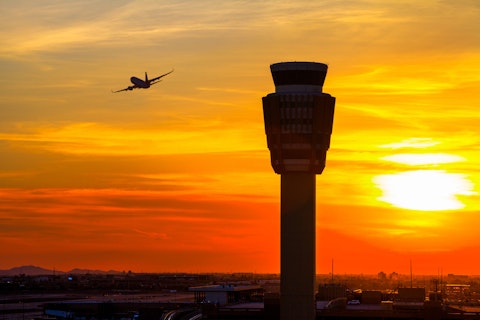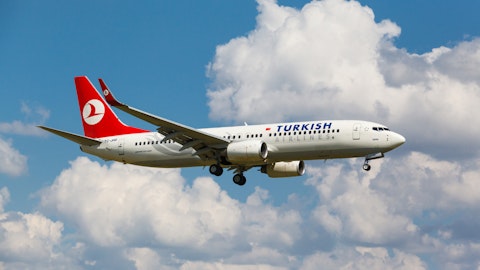Textron Inc. (NYSE:TXT) Q4 2022 Earnings Call Transcript January 25, 2023
Operator: Ladies and gentlemen, thank you for standing by. Welcome to the Fourth Quarter 2022 Textron Earnings Release Conference Call. At this time, all participants are in a listen-only mode. . As a reminder, this conference is being recorded. I would now like to turn the conference over to your host Vice President, Investor Relations, Mr. Eric Salander. Please go ahead.
Eric Salander: Thanks, Greg, and good morning, everyone. Before we begin, I’d like to mention we will be discussing future estimates and expectations during our call today. These forward-looking statements are subject to various risk factors, which are detailed in our SEC filings, and also in today’s press release. On the call today, we have Scott Donnelly, Textron’s Chairman and CEO, and Frank Connor, our Chief Financial Officer. Our earnings call presentation can be found in the Investor Relations section of our website. Revenues in the quarter were $3.6 billion, up $3.3 billion in last year’s third quarter. Segment profit in the quarter was $317 million, up $7 million from the fourth quarter of ’21. During this year’s fourth quarter, we reported income from continuing operations of $1.07 per share.
Manufacturing cash flow before pension contributions totaled $368 million in the quarter, up $70 million from last year’s fourth quarter. For the full year, revenues were $12.9 billion up from $487 million from last year. In 2022, segment profit was $1.2 billion up $89 million from 2021. Income from continuing operations was $4.01 per share, compared to $3.30 in 2021. Manufacturing cash flow before pension contributions was $1.2 billion, up $29 million from 2021. With that, I’ll turn the call over to Scott.

benemale/Shutterstock.com
Scott Donnelly: Thanks, Eric, and good morning, everyone. Our business closed out the year with another strong quarter. In the quarter aviation grew revenue and segment profit reflecting high record deliveries increased aftermarket volume and strong pricing net of inflation as compared to last year’s fourth quarter. Also in the quarter, we continue to see solid order flow customer demand across our aircraft product portfolio ended the year with 6.4 billion of backlog. For the year we delivered 178 jets up from 167 last year, and 146 commercial turboprops up from 125 in 2021. Textron aviation defense delivered 10 T6 aircraft for the year up from five year a ago. Throughout 2022, strong aircraft utilization within the Textron aviation product portfolio resulted in a 16% growth in aftermarket revenues.
At bell, as expected revenues were down slightly in the quarter on lower military revenue reflecting the continued wind down on the H1 program partially offset by higher commercial revenue. In December, U.S. Army announced the Bells V-280 Valor was selected as the winner of the future long range assault aircraft program competition. This award is a testament to the hard work of the Bell team that designed built and flew V-280 prototype over the last 10 years in support of this win. The initial flyer contract award of up to 1.3 billion over the first 19 months with an initial funding of 232 million for engineering and manufacturing development related activity is currently on hold pending the outcome of protest was filed at year-end by the competing vendor.
On the commercial side of Bell, we delivered 179 helicopters in 2022, up from 156 in 2021. Moving to Textron systems revenues were essentially flat with last year’s fourth quarter. During the fourth quarter systems awarded another anti-vehicle munition contract from the U.S. Army. The award is valued at $162 million over five-year period performance. In December, Systems announced the delivery of the Cottonmouth to the U.S. Marine Corps for testing through 2023. This vehicle was purpose built for the Marines Advanced Reconnaissance Vehicle Program. Also in the quarter system delivered to the fixed Ship-to-Shore Connector to the U.S. Navy after the successful completion with substance trials. Moving to industrial, we saw high revenue in the quarter driven by higher volume, both Caltex and Specialized Vehicles, and favorable pricing principally in specialized vehicles.
Moving to aviation, we delivered 6 Bell aircraft in the fourth quarter, including the first unit into Canada. For the year, delivered 61 aircraft following the completion of the acquisition in April 2022. In summary, we saw strong demand across our commercial product lines and the team as executed well despite supply chain and labor constraints. At aviation, the team executed very well with a full year segment profit margin of 11.5%. It was above the high-end of our original guidance range. Aviation’s backlog grew 55% to 6.4 billion at year end on strong border activity and customer demand. On the new product front, we received FAA certification for the Cessna SkyCourier and delivered 6 units to our launch customer, FedEx, during 2022. The Textron Aviation Defense, the Light-Attack 86 Wolverine achieved military type certification from the U.S. Air Force, enabling the first international sale of 8 aircraft.
At Bell, the December 2022 FLRAA contract, award has solidified the long-term outlook for the segment and should provide an increasing revenue stream that we expect will drive growth well into the future. On FLRAA, the 360 Invictus is nearly complete, and we expect first flight 2023, pending delivery of the ICAP engine. At Textron Systems, we advanced our weapons programs with the award of our anti-vehicle munitions programs, continued work on the robotic combat vehicle and Armor Reconnaissance Vehicle Development Programs. Systems also obtained airworthiness certifications for 4 additional F1s at ATAC, bringing the total operational F1 fleet to 23 aircraft in support of increased demand across U.S. military tactical air programs. At Textron Specialized Vehicles, the company continued its leadership in the development and production of zero emission gulf vehicles, turf maintenance equipment and ground support equipment to markets.
At Caltex in 2022, we were awarded contracts on 14 hybrid electric vehicle programs for our fuel systems. At Aviation, the Pipistrel Velis Electro continued to receive certifications from around the world and is now certified in more than 30 countries. Looking to 2023. At Aviation, we are projecting growth driven by increased deliveries across all product lines and higher aftermarket volume. At Bell, we’re projecting revenue growth in 2023 on higher military revenues from the FARA program and higher commercial revenues. At Systems, we’re expecting mid-single-digit revenue growth across our businesses. At Industrial, we’re expecting revenue growth at specialized vehicles and Caltex. At Aviation, we plan to continue investments in development of technologies and products supporting sustainable flight solutions for unmanned cargo, next-generation electric trainers, EV tolls and general aviation.
With this overall backdrop, we’re projecting revenues of about $14 billion for Textron’s 2023 financial guidance, projecting adjusted EPS in the range of $5 to $5.20. Manufacturing cash flow before pension contributions is expected to be in the range of $900 million to $1 billion. With that, I’ll turn the call over to Frank.
See also 11 Best Performing S&P 500 Stocks in 10 Years and 25 Strongest Countries in Europe
Frank Connor: Thanks, Scott, and good morning, everyone. Let’s review how each of the segments contributed, starting with Textron Aviation. Revenues at Textron Aviation of $1.6 billion were up $223 million from a year ago, reflecting higher jet and defense volume and higher pricing. Segment profit was $169 million in the fourth quarter, up $32 million from last year’s fourth quarter due to favorable pricing, net of inflation of $29 million and higher volume and mix, partially offset by an unfavorable impact from performance. Performance includes unfavorable manufacturing performance largely related to inefficiencies from supply chain disruptions and increased staffing associated with higher production, partially offset by lower selling and administrative costs.
Backlog in the segment ended the quarter at $6.4 billion. Moving to Bell. Revenues were $816 million, down $42 million from last year, reflecting lower military revenues, partially offset by higher commercial revenues. Segment profit of $71 million was down $17 million from a year ago, primarily reflecting lower military volume and mix, partially offset by a favorable impact from performance. Backlog in the segment ended the quarter at $4.8 billion. At Textron Systems, revenues were $314 million, up $1 million from last year’s fourth quarter. Segment profit of $40 million was down $5 million from a year ago. Backlog in the segment ended the quarter at $2.1 billion. Industrial revenues were $907 million, up $126 million from last year, reflecting higher in volume and mix of $95 million and a $59 million favorable impact from pricing largely at specialized vehicles product line, partially offset by an unfavorable impact of $28 million from foreign exchange rate fluctuations.
Segment profit of $42 million was up $4 million from the fourth quarter of 2021, primarily due to higher volume and mix, partially offset by an unfavorable impact from performance. Textron eAviation segment revenues were $6 million and segment loss was $10 million in the fourth quarter of 2022, which reflected the operating results of Pipistrel along with research and development costs for initiatives related to the development of sustainable aviation solutions. Finance segment revenues were $11 million, and profit was $5 million. Moving below segment profit, corporate expenses were $43 million in the fourth quarter. Interest expense, net for the manufacturing group was $17 million. Our manufacturing cash flow before pension contributions was $368 million in the quarter.
For the year, manufacturing cash flow before pension contributions totaled $1.2 billion, up $29 million from the prior year despite higher cash tax payments of $284 million in 2022 related to the R&D tax law change. In the quarter, we repurchased approximately 3.3 million shares, returning $228 million in cash to shareholders. For the full year, we repurchased approximately 13.1 million shares, returning $867 million in cash to shareholders. Beginning in the first quarter of 2023, we’ll change how we measure our segment results. Going forward, we will exclude from segment profit, the LIFO inventory provision, intangible asset amortization and the non-service component of pension and postretirement income or expense. These items will be separately reported on the income statement below segment profit.
We believe these changes will provide a more consistent method of measuring and evaluating business performance across our segments, while also aligning our reporting results more consistently with other companies within our industry. On Slide 15 and 16 in the investor presentation posted to our website, you will find prior year results, reflecting the recast of segment profit. Also effective with the first quarter of 2023 results we will report earnings per share on an adjusted basis that excludes the LIFO inventory provision and intangible asset amortization, both non-cash items. Turning now to our 2023 outlook on Slide 9. We’re expecting adjusted earnings per share to be in a range of $5 to $5.20 per share. We’re also expecting manufacturing cash flow before pension contributions to be about $900 million to $1 billion.
Moving to segment outlook on Slide 11 and beginning with Textron Aviation. We’re expecting revenues of about $5.7 billion; segment margin is expected to be in a range of approximately 12% to 13%. Looking to Bell, we expect revenues of about $3.3 billion. We’re forecasting a margin in a range of 8.25% to 9.25%. At Systems, we’re estimating revenues of about $1.25 billion with a margin in a range of about 10.75% to 11.75%. At Industrial, we’re expecting segment revenues of about $3.6 billion and margin to be in the range of about 5% to 6%. At eAviation, we expect revenues of $45 million and a segment loss of $65 million, largely reflecting our continued investments in sustainable aviation solutions. Lastly, at finance, we’re forecasting a profit of about $15 million.
Looking at Slide 12, we’re projecting about $150 million of corporate expense. We’re also projecting about $90 million of net interest expense; $130 million of LIFO inventory provision; $35 million of intangible asset amortization; and $235 million of non-service pension income. We expect a full year effective tax rate of approximately 17.5%. Turning to Slide 13. R&D is expected to be about $585 million, down from $601 million last year. We’re estimating CapEx will be about $425 million, up from $354 million in 2022. Our outlook assumes an average share count of about 205 million shares in 2023. That concludes our prepared remarks. So Greg, you can open the line for questions.
Q&A Session
Follow Textron Inc (NYSE:TXT)
Follow Textron Inc (NYSE:TXT)
Receive real-time insider trading and news alerts
Operator: . Your first question comes from the line of Sheila Kahyaoglu from Jefferies. Please go ahead.
Sheila Kahyaoglu: You’ve definitely had a busy quarter between FARA. So congratulations on that. And I think you threw in an Aerojet bid and as well. So I wanted to focus on aviation margins. In Q4, I think you ended at 10.7%, potentially lower, including the recasting for LIFO. How do we think about the walk to the 12.5% margins in 2023?
Scott Donnelly: Well, I think, Sheila — so first of all, the quarter, we knew that we were going to have some headwind with supply chain. And obviously, we brought a lot of new people on board which is a good thing but had a lot of impacts just getting all those folks on and training and those kinds of interruptions. So in the quarter, we did take a lot of those unusual impacts right to expense in the quarter rather than putting it into in inventory. So we did take a hit on that. LIFO was still in there, obviously, in that reported number. So obviously, on a recast basis going forward, that will be there. So I think when we think about what happens as we go into 2023, obviously, you’re going to not have the LIFO in there. And I think we’re going to see, again, we’re guiding probably almost $0.5 billion of higher revenue, and that converts at good margins. So I think we’re pretty bullish on our ability to drive higher margins as we go through 2023.
Sheila Kahyaoglu: And maybe just as a follow-up to that longer term, like how do you think about peak trough margins in aviation? Is it just steady as it goes from here? Can it just be a 20% incremental margin business?
Scott Donnelly: Well, as you know, Sheila, based on analyst pressures, we’ve been striving to get above 10% margins in the aviation business. And we feel pretty good about that. So look, I think it’s going to be very much volume driven. You guys know we tend to convert somewhere in that 20%, 25% range. I expect we can continue that as we go forward. Certainly, we’re guiding that in our conversion for 2023 and as we go beyond that, we’ll just have to see where the market is. The good news is demand has remained strong. The fourth quarter demand remained strong, and with good bookings in Q4. So environment, I think we feel pretty good about. But in terms of what margins do on a go-forward basis. I think we would kind of remain in that neighborhood of expecting sort of a 20%, 25% conversion on our revenue growth.
Sheila Kahyaoglu: Great. Thank you.
Operator: Your next question comes from the line of David Strauss from Barclays. Please go ahead.
David Strauss: Scott, could you just talk through the forecast at Bell, so up revenue, down margins, decent amount. You mentioned it includes FLRAA. So what exactly is your assumption for FLRAA? Does that assume you win it post protest? Just if you could help there.
Scott Donnelly: Sure, David. It does. So the protest period ends at the first week of April. So we’ve baked that into our estimates, assuming that will be resolved by that period of time. Obviously, the dynamics in terms of margin is that we will continue to see a decline on the military revenue side. There’ll be some offset on the commercial revenue side. We’ve had a good year in terms of bookings and expect to see nice growth on the commercial side. And then obviously, we’ll have 3/4 of the FLRAA program coming in, which is good, but that is a lower margin business. I mean EMD programs tend to be lower margin, and that’s what we’ve forecast in our guide for you for ’23.





